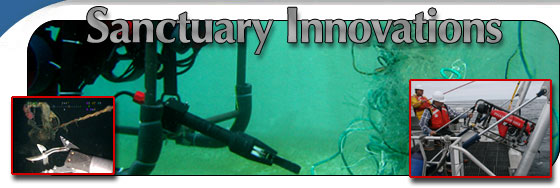Error processing SSI file
|
About Remote Operated Vehicles
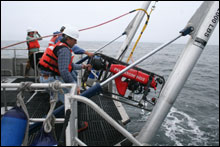 |
| ROV being pulled back on deck of R/V Fulmar. (Photo: Michael Carver, Cordell Bank National Marine Sanctuary) |
Remote operated vehicles (ROV) are one tool that scientists use to investigate deep marine environments such as Cordell Bank. ROVs are attached to the ship by a long cable, but propellers on the vehicle allow it to move independently of the ship. An ROV pilot controls the movement of the underwater vehicle using a joystick. If you have ever played a video game with a joystick, you pretty much get the idea of how this works. The vehicle can contain a variety of different tools on it, including lights to penetrate the dark environment, video and still cameras, and various arm attachments for carrying out work on the seafloor.
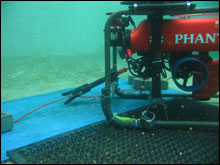 |
| ROV testing cutting arm in pool. (Photo: Cordell Bank National Marine Sanctuary) |
The remote operated vehicle used on this mission is relatively small and is restricted to use in shallower depths (<600ft). Some ROVs can weigh up to 8000lbs. and travel to depths over 20,000ft. The size of the ROV and its complexity dictates the type of vessel that is needed to support the operation. ROVs can be deployed over the side of a research vessel using a crane or can be deployed off of the stern of the vessel using an A-frame.
In both cases, a winch is needed to control the amount of cable that is sent out, which controls the depth that the ROV reaches.
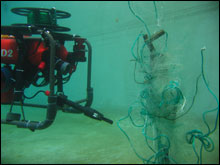 |
| ROV tests cutting gear in pool. (Photo: Cordell Bank National Marine Sanctuary) |
The remote operated vehicle that was used for this mission contains two different arm attachments that were specifically designed to meet the requirements of the mission. One arm includes a claw equipped with blades for cutting line, including pieces of long lines and gill nets. The other arm is designed for grasping items, including lost fishing gear, rock samples, and invertebrate samples. In addition to the mechanical arms, a carabiner clip and a spool of very strong line will be tested for bringing gear to the surface.
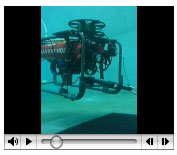 |
| ROV testing in pool at Bodega Marine Lab. Click here to play the movie. (Movie: Cordell Bank National Marine Sanctuary) |
To ensure that the ROV and arm attachments would be able to accomplish the tasks that were planned for the marine debris removal operations, pool tests were completed. Pieces of gear were placed on the pool bottom in various configurations, and the ROV was put to the test
Overall, the pool trials were successful.
Nevertheless, some modifications were needed to improve the capability of the vehicle. After the ROV spent some time in the shop, it was ready to tackle its mission on Cordell Bank!
|

